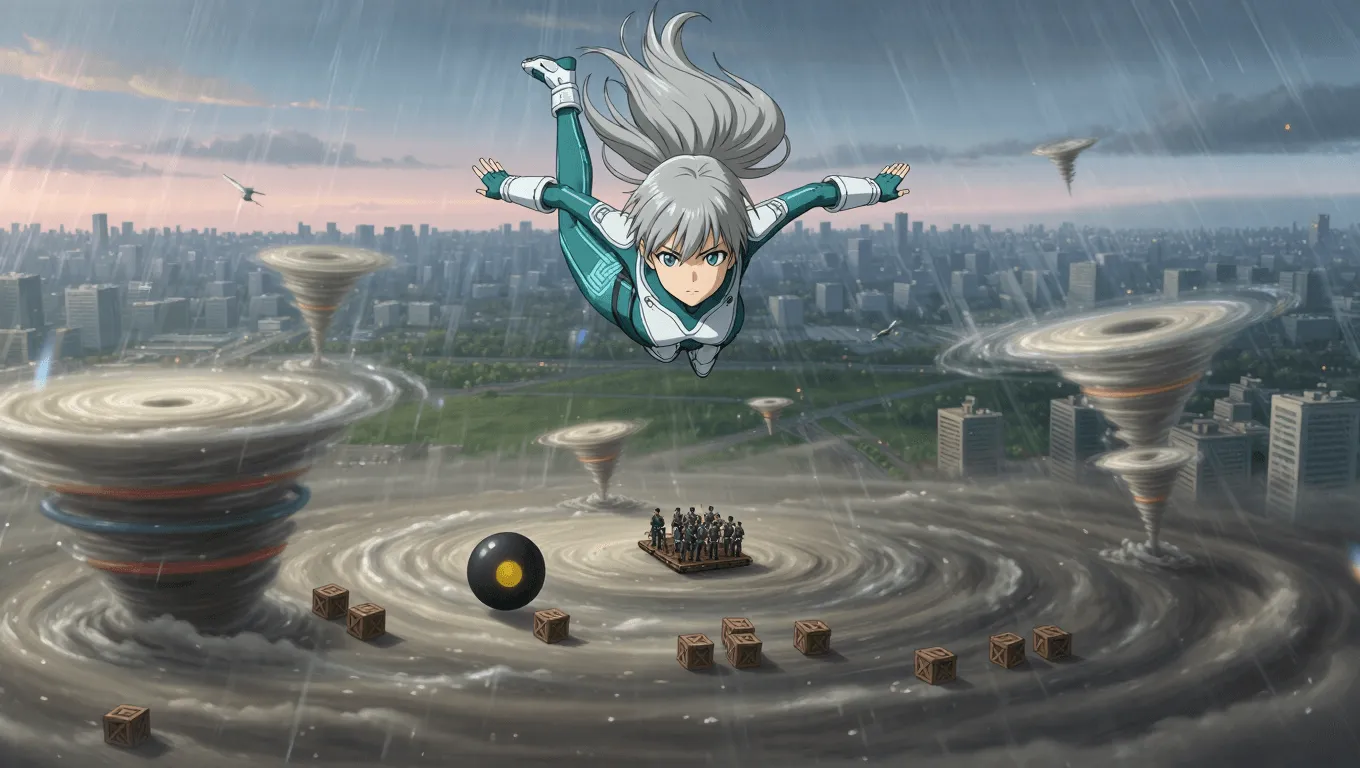Tornado Creation

Tornado Creation Video Demo 🎬
Table of Contents
Tornado Creation is the ability to generate, shape, and command tornadoes at will. Often classified under aerokinesis, wind manipulation, and atmospheric manipulation, this power focuses on controlled cyclogenesis—forming a rotating column of air that can be directed for mobility, defense, or overwhelming offense. Masters of Tornado Creation read barometric pressure changes, adjust wind shear, and regulate vortex intensity to produce precise results, from gentle dust devils to city-sweeping supercells. For more powers like this, explore the full superpower wiki or try the random superpower generator.
What Is Tornado Creation
Tornado Creation is a specialized subset of storm generation that lets a user trigger and sustain a coherent, spinning updraft (mesocyclone) and extend it to ground level to form a tornado. Unlike general weather control, which manipulates broad atmospheric systems over time, this superpower emphasizes rapid, tactical vortices shaped in seconds. Practitioners control inflow, rotation (counterclockwise or clockwise depending on hemisphere or intent), condensation funnel formation, and debris entrainment. The result is a portable, programmable storm tool that can be deployed with surgical precision on the battlefield or scaled up for large-area effects.
Core Abilities of Tornado Creation
Controlled Cyclogenesis
Users induce rotation by injecting angular momentum into converging air masses. They can seed a vortex from calm air, strengthen existing whirlwinds, or hijack natural storms. Precision control includes:
-
Adjusting updraft strength to determine funnel width and height
-
Modulating barometric pressure to influence suction and lift
-
Shifting the vortex track, speed, and tilt for accurate steering
Vortex Shaping and Scaling
From wrist-sized microvortices to multi-hundred-meter funnels, scaling gives diverse options:
-
Microtornadoes: Pinpoint disruption of enemy footing, extinguishing flames by oxygen-starving micro-spins, or disarming opponents by plucking objects from hands
-
Battlefield Tornadoes: Crowd control, barrier breaking, vehicle flipping, and visibility denial via dust and debris
-
Aerial Columns: Vertical shafts for rapid ascent/descent, improvising elevators or evacuations
Aerokinetic Force Application
The rotating winds act like a variable-output engine:
-
Kinetic Impact: Throwing projectiles, hurling adversaries, collapsing fragile fortifications
-
Pressure Lensing: Creating low-pressure cores to tug targets upward or sideways
-
Shear Blades: Thin, fast eddies that slice through smoke, fog, or loose materials
Defensive Wind Shields
A vortex can be “hollowed out” to act as a surrounding barrier. Incoming projectiles curve off course, gases disperse, and energy beams refract in turbulent air. Layered vortices form nested defenses, each tuned to deflect a different threat profile.
Mobility and Flight
By positioning the user at the calm eye (or a stabilized annulus) of a controlled funnel, Tornado Creation enables:
-
Vertical boost: Updraft-assisted leaps and controlled descents
-
Horizontal surfing: Riding slanted vortices to glide at high speed
-
Rapid redeployment: Pop-up funnels that relocate the user or allies over obstacles
Environmental Engineering
Tornadoes can clear smoke, dissipate toxic clouds, seed rainfall by lifting moist air, and create temporary firebreaks by depriving flames of oxygen. In arctic or desert theaters, users can redistribute snow or sand for tactical shaping of the terrain.
Application / Tactical Advantages in Combat
-
Area Denial: One well-placed funnel can force enemies to scatter, pause advances, or surrender high ground.
-
Disarm and Disperse: Lift and scatter munitions, tear down shields, and separate coordinated units.
-
Non-Lethal Control: Dial down wind speed to create stumbling, disorienting gusts without catastrophic damage—useful for captures and evacuations.
-
Counter-Stealth: Vortices shred smoke screens and distort sound and sight lines, exposing concealed threats.
-
Siege-Breaking: Focused funnels can pry open gates, peel roofs, and uproot barricades while minimizing collateral ignition compared to explosives.
-
Rapid Extraction: Tornado-assisted hoists can lift allies from collapsing structures or hot zones.
Level: Level 1 🏙️, Level 2 🌇, Level 3 🌃
Level 1 — Novice Whirlcaller

-
Can create small dust devils and 2–5 m wide funnels lasting under 30 seconds
-
Basic steering at walking speed, limited altitude gain
-
Useful for crowd spacing, smoke clearing, and projectile deflection at short range
-
Requires visible hand gestures or focus chants; loses control under stress
-
Common keywords at this stage: wind manipulation, mini vortex, airflow control
Level 2 — Seasoned Tempest Shaper

-
Sustains 10–50 m wide tornadoes for minutes; can stack two smaller funnels at once
-
Precise steering at vehicle speeds, moderate altitude transport for self and one ally
-
Can tune suction to lift vehicles, uproot light structures, and neutralize drones
-
Establishes defensive wind walls, creates pressure gradients to curve bullets
-
Coordinates with other elemental users (e.g., hydrokinesis, electrokinesis) for advanced tactics
-
Begins reading battlefield meteorology: humidity, thermal updrafts, and wind shear
Level 3 — Apex Cyclone Architect

-
Commands multi-funnel arrays and supercell-like constructs with regulated eyewalls
-
Executes kilometer-scale area denial without losing friendly control
-
Flight becomes agile and long-range; can carry teams or heavy cargo safely
-
Performs fine-grained vortex surgery: plucking a single object from a pile, disarming explosives, or isolating toxins from ambient air
-
Integrates advanced atmospheric manipulation: temperature differentials, microbarometric lensing, and turbulence damping to reduce collateral damage
-
Capable of “silent vortices” with reduced roar for stealth operations
Limitations of Using the Tornado Creation
-
Energy and Stamina Drain: Sustained rotation is metabolically taxing; overuse leads to vertigo, dehydration, and microtears in respiratory tissues from dry, fast airflow.
-
Environmental Dependence: Extremely stagnant, humid, or thin air can impede funnel formation. High-altitude or subterranean arenas limit room for rotation.
-
Collateral Risks: Debris entrainment is unpredictable in urban zones. Friendly fire from flying objects and shrapnel is a constant management challenge.
-
Acoustic Signature: Even “quiet” funnels generate telltale rumble; stealth requires deliberate damping, which further drains power.
-
Line-of-Sight Steering: While advanced users can “feel” pressure lines, most need sightlines for precision control, making smoke or blizzards problematic.
-
Conductivity Hazards: In thunder-prone conditions, a tall vortex may encourage lightning strikes unless the user mitigates charge separation.
-
Regulatory/Ethical Concerns: Large-scale deployment can be viewed as weather warfare. Responsible use involves containment protocols and evacuation planning.
Weakness Against What Other Superpowers
-
Earth Manipulation (Geokinesis): Ground anchors, instant trenches, and rock bulwarks break inflow symmetry and rob the tornado of fuel.
-
Gravity Control: Localized gravity wells or vector shifts disrupt vertical updrafts, collapsing the funnel.
-
Vacuum/Pressure Manipulation: Counter-rotating pressure fields or sudden isobar flattening de-coheres the vortex core.
-
Sound Manipulation (Sonokinesis): Focused infrasound can destabilize shear layers, causing the funnel to wobble and dissipate.
-
Temperature Control (Cryokinesis/Thermokinesis): Homogenizing air temperature eliminates buoyancy and stalls updraft-driven rotation.
-
Water/Ice Barriers (Hydrokinesis/Cryoforms): Dense, cohesive sheets of rain or ice baffles scatter angular momentum and sap wind energy.
-
Telekinesis/Forcefields: Stiff, non-aerodynamic barriers ignore aerodynamic rules, blocking or redirecting the vortex entirely.
-
Plant Manipulation: Rapid-growth root nets, thorn walls, and moisture-rich canopies dampen ground-level inflow.
Synergistic Power Combos
-
Electrokinesis: Pairing lightning with a stabilized funnel yields devastating, guided strikes. The vortex columns channel ionized air, improving accuracy.
-
Hydrokinesis: Water-laden vortices act as moving fire hoses or smother incendiaries. Rain-infused funnels also cool overheated zones.
-
Thermokinesis/Cryokinesis: Heating boosts buoyancy for stronger updrafts; strategic cooling can “pin” the vortex in place with ice anchors or freeze debris to reduce shrapnel risk.
-
Pressure Manipulation: Fine pressure tuning polishes steering and lets users shape “donut” vortices that trap but don’t shred targets.
-
Flight/Teleportation: Mobility partners help deploy funnels at multiple fronts or extract allies while the tornado holds enemies at bay.
-
Metal Manipulation (Ferrokinesis): Curating debris into controlled shrapnel rings can create non-lethal shock displays or precision anti-armor swarms.
-
Sound Dampening: A partner who cancels the roar preserves stealth and team comms.
Known Users
-
Storm (Ororo Munroe) — A leading weather-controlling mutant known for summoning cyclones with surgical precision, tactical restraint, and atmospheric finesse.
-
Red Tornado — An android hero who generates controlled whirlwinds and tornadoes for flight, shielding, and battlefield control.
-
Captain Planet — Often depicted channeling wind to form powerful spirals and gusts for environmental interventions.
-
The Tornado Tyrant — A classic adversary with autonomous vortex-creation capabilities that test the limits of aerokinetic defense.
By mastering Tornado Creation—from microvortex finesse to supercell-scale constructs—users can transform the battlefield with intelligent windcraft. For more abilities, visit the comprehensive superpower wiki or discover a new gift with the random superpower generator.
